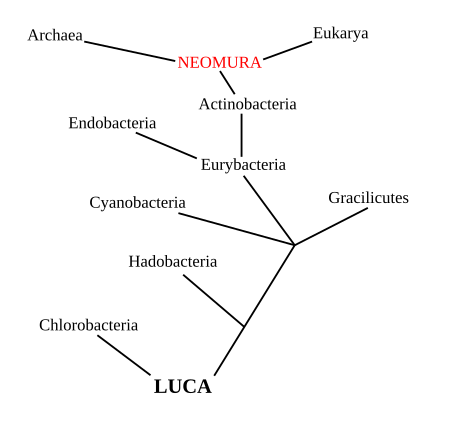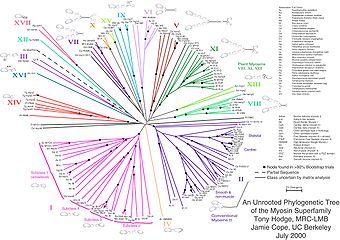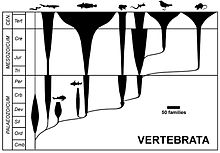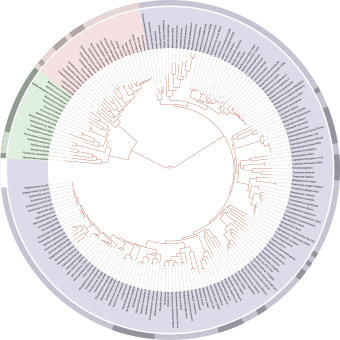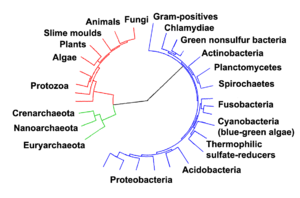In evolutionary biology, an evolutionary arms race is a struggle between competing sets of co-evolving genes, traits, or species, that develop adaptations and counter-adaptations against each other, resembling an arms race. These are often described as examples of positive feedback.[1] The co-evolving gene sets may be in different species, as in an evolutionary arms race between a predator species and its prey (Vermeij, 1987), or a parasite and its host. Alternatively, the arms race may be between members of the same species, as in the manipulation/sales resistance model of communication (Dawkins & Krebs, 1979) or as in runaway evolution or Red Queen effects. One example of an evolutionary arms race is in sexual conflict between the sexes, often described with the term Fisherian runaway. Thierry Lodé[2] emphasized the role of such antagonistic interactions in evolution leading to character displacements and antagonist coevolution. The escalation hypothesis put forward by Geerat Vermeij speaks of more general conflicts and was originally based on his work with marine gastropod fossils.
Co-evolution itself is not necessarily an arms race. For example, mutualism may drive co-operative adaptations in a pair of species. This is the case with certain flowers' ultra-violet color patterns, whose function is to guide bees to the center of the flower and promote pollination. Co-evolution is also interspecific by definition; it excludes intraspecific arms races such as sexual conflict.
Evolutionary arms races can even be displayed between humans and micro-organisms, where medical researchers make antibiotics, and micro-organisms evolve into new strains that are more resistant.
Evolutionary arms races often evolve when a trait is only beneficial compared to the population. For instance, if a tree has a mutation making it taller, it will have an advantage due to more sunlight. But as soon as other trees reach the same height, it loses that advantage. As soon as a taller tree appears, it has the advantage. In this example, the nearest peak of the evolutionary landscape moves as the population approaches it. Another example of runaway evolution in sexual selection is an elk's antlers. Having big antlers makes a male elk more likely to win a mate. In fact, having big antlers is a requirement to mate. As a result, elk evolve antlers that are incredibly costly to build, maintain, and fight with. By the end of the mating season, the average male loses 25% of his body weight [3] due to fighting, which he has to make up before winter starts.
Symmetrical versus asymmetrical arms races
Arms races may be classified as either symmetrical or asymmetrical. In a symmetrical arms race, selection pressure acts on participants in the same direction. An example of this is trees growing taller as a result of competition for light, where the selective advantage for either species is increased height. An asymmetrical arms race involves contrasting selection pressures, such as the case of cheetahs and gazelles, where cheetahs evolve to be better at hunting and killing while gazelles evolve not to hunt and kill, but rather to evade capture.[4]Host-parasite dynamic
Selective pressure between two species can include host-parasite coevolution. This antagonistic relationship leads to the necessity for the pathogen to have the best virulent alleles to infect the organism and for the host to have the best resistant alleles to survive parasitism. As a consequence, allele frequencies vary through time depending on the size of virulent and resistant populations (fluctuation of genetic selection pressure) and generation time (mutation rate) where some genotypes are preferentially selected thanks to the individual fitness gain. Genetic change accumulation in both population explains a constant adaptation to have lower fitness costs and avoid extinction in accordance with the Red Queen's hypothesis suggested by Leigh Van Valen in 1973.Examples
The Phytophthora infestans/Bintje potato interaction
The Bintje Potato is derived from a cross between Munstersen and Fransen potato varieties. It was created in the Netherlands and now is mainly cultivated in the North of France and Belgium. The oomycete Phytophthora infestans is responsible for the potato blight, in particular during the European famine in 1840. Zoospores (mobile spores, characteristics of oomycetes) are liberated by zoosporangia provided from a mycelium and brought by rain or wind before infecting tubers and leaves. Black colours appear on the plant because of the infection of its cellular system necessary for the multiplication of the oomycete infectious population. The parasite contains virulent-avirulent allelic combinations in several microsatellite loci, likewise the host contains several multiloci resistance genes (or R gene). That interaction is called gene-for-gene relationship and is, in general, widespread in plant diseases. Expression of genetic patterns in the two species is a combination of resistance and virulence characteristics in order to have the best survival rate.Bats and moths
Bats have evolved to use echolocation to detect and catch their prey. Moths have in turn evolved to detect the echolocation calls of hunting bats, and evoke evasive flight maneuvers,[5][6] or reply with their own ultrasonic clicks to confuse the bat's echolocation.[7] The Arctiidae subfamily of Noctuid moths uniquely respond to bat echolocation in three prevailing hypotheses: startle, sonar jamming, and acoustic aposematic defense.[8] All these differences depend on specific environmental settings and the type of echolocation call; however, these hypotheses are not mutually exclusive and can be used by the same moth for defense.[8] The different defense mechanisms have been shown to be directly responsive to bat echolocation through sympatry studies. In places with spatial or temporal isolation between bats and their prey, the moth species hearing mechanism tends to regress. Fullard et al. (2004) compared adventive and endemic Noctiid moth species in a bat-free habitat to ultrasound and found that all of the adventive species reacted to the ultrasound by slowing their flight times, while only one of the endemic species reacted to the ultrasound signal, indicating a loss of hearing over time in the endemic population.[5] However, the degree of loss or regression depends on the amount of evolutionary time and whether or not the moth species has developed secondary uses for hearing.[9] Some bats are known to use clicks at frequencies above or below moths' hearing ranges.[7] This is known as the allotonic frequency hypothesis. It argues that the auditory systems in moths have driven their bat predators to use higher or lower frequency echolocation to circumvent the moth hearing.[10]Barbastelle bats have evolved to use a quieter mode of echolocation, calling at a reduced volume and further reducing the volume of their clicks as they close in on prey moths.[7] The lower volume of clicks reduces the effective successful hunting range, but results in a significantly higher number of moths caught than other, louder bat species.[7][11] Moths have further evolved the ability to discriminate between high and low echolocation click rates, which indicates whether the bat has just detected their presence or is actively pursuing them.[7] This allows them to decide whether or not defensive ultrasonic clicks are worth the time and energy expenditure.[12]The rough-skinned newt and the common garter snake
Rough-skinned newts have skin glands that contain tetrodotoxin (TTX) as a defense against predation. This toxin binds reversibly to sodium channels in nerve cells and interferes with the normal flow of sodium ions in and out of the cell. This has the effect of inducing paralysis and death. Throughout much of the newt’s range, the common garter snake has been observed to exhibit resistance to the tetrodotoxin in the newts' skin. While in principle the toxin binds to a tube shaped protein that acts as a sodium channel in the snake's nerve cells, researchers have identified a genetic mutation in several snake populations where the protein is configured in such a way as to hamper or prevent binding of the toxin. In each of these populations, the snakes exhibit resistance to the toxin and successfully prey upon the newts. The mutations in the snake’s genes that conferred resistance to the toxin have resulted in a selective pressure that favors newts that produce more potent levels of toxin. Increases in newt toxicity then apply a selective pressure favoring snakes with mutations conferring even greater resistance. This evolutionary arms race has resulted in the newts producing levels of toxin far in excess of what is needed to kill any other conceivable predator. Toxin-resistant garter snakes are the only known animals today that can eat a rough-skinned newt and survive.[13][14][15] The interactions between garter snakes and newts have been studied to understand the coevolution between the two species. In populations where the two live together, higher levels of TTX and resistance to TTX are observed in newts and garter snakes respectively. In populations where the species are separated, the TTX levels and resistance are lower when compared to the sympatric populations.[16] While isolated garter snakes have lower resistance, they still demonstrate an ability to resist low levels of TTX exposure. This fact suggests that garter snakes are predisposed to the development of TTX resistance and that it may be an ancestral trait.[17] The resistance of garter snakes is measured by observing a snake’s crawling speed after it has ingested or been injected with TTX. The most resistant snakes continue to crawl at normal speeds even after high levels of TTX have been given. The snakes on the lower end of the spectrum show decreased movement and signs of paralysis when exposed to TTX.[18] The lower levels of resistance observed in separated populations of newts and garter snakes suggest that there is a fitness cost associated with both TTX production and resistance. The snakes with high levels of TTX resistance have slower average crawl speeds when compared to isolated populations of snakes.[19] Slower crawl speeds make the snakes more susceptible to predators. This illustrates that while it is advantageous to be resistant to TTX when newts are present, it becomes more costly in the absence of selective pressures from the newt. The same pattern is seen in isolated populations of newts. In these populations, where garter snakes are absent, newts have lower levels of TTX in their skin. This demonstrates that there is some cost to the newt to have a high level of toxin.[20] This relationship creates a geographic pattern of resistance in populations. There are areas known as hotspots in which levels of TTX and resistance are extremely high. This alludes to a close interaction between newts and snakes. There are also areas of coldspots where newts and snakes have minimal interaction, leading to lower levels of TTX production and resistance.[19]Predator whelk and the hard-shelled bivalve prey
The whelk predators used their own shell to open the shell of their prey, oftentimes breaking both shells of the predator and prey in the process. This led to the fitness of larger-shelled prey to be higher and then more selected for through generations, however, the predator’s population selected for those who were more efficient at opening the larger-shelled prey.[21] This example is an excellent example of asymmetrical arms race because while the prey is evolving a physical trait, the predators are adapting in a much different way.Floodplain death adders and separate species of frogs
Phillips and Shine did a study with the chemical defenses of toxic frogs in response to a snake predator, the floodplain death adders. These snakes eat three types of frogs, one nontoxic, one producing mucus when taken by the predator, and the highly toxic frogs, however, the snakes have also found if they wait to consume their toxic prey the potency decreases. In this specific case, the asymmetry enabled the snakes to overcome the chemical defenses of the toxic frogs after their death.[22] The results of the study showed that the snake became accustomed to the differences in the frogs by their hold and release timing, always holding the nontoxic, while always releasing the highly toxic frogs, with the frogs that discharge mucus somewhere in between. The snakes would also spend generously more time gaped between the release of the highly toxic frogs than the short gaped time between the release of the frogs that discharge mucus. Therefore, the snakes have a much higher advantage of being able to cope with the different frogs defensive mechanisms, while the frogs could eventually increase the potency of their toxic knowing the snakes would adapt to that change as well, such as the snakes having venom themselves for the initial attack.[22] This study showed that even with the dangerous prey, the coevolution is still highly asymmetrical because of the incredible advantage the predators have compared to the prey.Introduced species
Cane Toads have experienced a massive population explosion in Australia due to the lack of competition.
When a species has not been subject to an arms race previously, it may be at a severe disadvantage and face extinction well before it could ever hope to adapt to a new predator, competitor, etc. This should not seem surprising, as one species may have been in evolutionary struggles for millions of years while the other might never have faced such pressures. This is a common problem in isolated ecosystems such as Australia or the Hawaiian Islands. In Australia, many invasive species, such as cane toads and rabbits, have spread rapidly due to a lack of competition and a lack of adaptations to cane toad bufotenine on the part of potential predators. Introduced species are a major reason why some indigenous species become endangered or even extinct, as was the case with the dodo.


